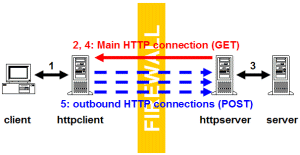
 |
HTTPTunnel v1.2.1©2010 by Sebastian Weber <webersebastian at yahoo.de>This software is licensed under the GNU general public license | Powered by |
 |
| Introduction to HTTPTunnel |
|---|
HTTPTunnel is a tunneling software that can tunnel network connections through
restrictive HTTP proxies over pure HTTP "GET" and "POST" requests.


Configuration of all components is done over a web-based GUI. SOCKS proxy cascading is supported. |
| Main features of HTTPTunnel |
|
| To download the HTTPTunnel package, follow this link: Download HTTPTunnel |
| Requirements |
|---|
ActivePerl is currently the most popular way to get Perl for Windows. Unfortunately, most current perl distributions do not have the most recent threads module included. If you get a warning from HTTPTunnel about your threads version, you should upgrade your threads module. Please check the FAQ for instructions on doing this. |
| Installation of HTTPTunnel Client and Server Perl Scripts |
To install the HTTPTunnel client and server Perl scripts, follow the steps below:
|
| Installation of HTTPTunnel PHP Server |
To install the HTTPTunnel PHP server, follow the steps below:
|
| Installation of HTTPTunnel Client and Server Win32 binaries |
| Double-click the installer - d'oh :-) |
| Usage of HTTPTunnel | ||||||||||||||||||
|---|---|---|---|---|---|---|---|---|---|---|---|---|---|---|---|---|---|---|
|
After you have successfully installed and set up the HTTPTunnel client and server, you can
test your setup by trying to establish your first tunnel connection. Start your network application and direct it either to a mapped port on the HTTPTunnel client or connect over the SOCKS proxy. If your application does not support SOCKS, there are utility programs that socksify, which allows adaptation of any software to connect to external networks via SOCKS, e.g.:
If your connection is successful - Congratulations, you set up your HTTPTunnel successfully. If not, check below under troubleshooting. | ||||||||||||||||||
| Troubleshooting | ||||||||||||||||||
If you're having problems, do the following:
| ||||||||||||||||||
| Usage and Command Line Options | ||||||||||||||||||
|
Usage: httptunnel_* [--debug] [--<varname>=<value> ...] [<configfilename>]
|
| Frequently Asked Questions |
|---|
The FAQ section is constantly growing - depending on what kind of feedback
and questions I get from people using HTTPTunnel.
|
| Troubleshooting |
|
Back to TopMy tunnel setup does not work - what can I do to find out the reason? The most obvious setup errors are discovered by just checking the HTTPTunnel client or server log. If the log does not provide sufficient information, you should start a systematic troubleshooting going through your whole chain of proxies:
Back to TopI get a warning about my threads version - what can I do? You need to upgrade your threads version. This is done by downloading the most recent version from CPAN and installing it. Unfortunately, for installation to work, you need a working C-compiler on your system. On most UNIX systems this is not an issue, but on other systems like Microsoft Windows it is. This is why a pre-compiled version of the threads module 1.61 for win32 and ActivePerl is included into the distribution package. Just unpack the zip file into your ActivePerl installation directory, overwriting existing files if necessary. Afterwards you should not get the warning about your threads version anymore. |
| Issues with the PHP server |
|
Back to TopThe PHP Server does not work - I see traffic coming in, but no traffic being sent. This is often a problem related to load-balanced web servers. Many webspace
providers distribute HTTP requests to a single address evenly among multiple
servers. Back to TopEven after checking the "Support load balanced servers" option the PHP server does not work. Then you're out of luck. Some webspace providers who use load balancing do not allow their servers to communicate with each other. This, however, is a prerequisite for the PHP server to work. Try if you can find a different webspace provider. Back to TopAuthentication does not work with the PHP Server For authentication to work, one of the following has to be true:
|
| Inside HTTPTunnel |
|
Back to TopCan you provide some details on the HTTPTunnel protocol? The HTTPTunnel client listens on configured network ports for incoming client connections. Each new client connection triggers the following sequence of actions. The HTTPTunnel client and server will be referred to as the "httpclient" and "httpserver" - the network client and server will be referred to as the "client" and "server": 
Back to TopHow exactly does HTTPTunnel encrypt network traffic? The network traffic is encrypted using a symmetric stream cipher (RC4) with a key length of 2048 bit. |
| Feedback, Feature Requests, Bug Reporting etc. |
|---|
Any kind of feedback is appreciated. I'm interessted in bug reports but also success stories.
As the HTTPTunnel project is hosted by Sourceforge.net, all feedback mechanisms are provided by them:
|
| Known Bugs / Limitations |
|---|
|
| HTTPTunnel Release Notes |
|